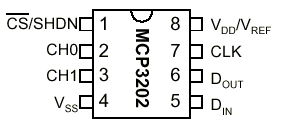Board to board communication using I2C protocol, is simple once you’ve done any other program using this protocol with arm7. Since I have interfaced arm7 with eeprom. The same code used to send data to the eeprom is been used,except for the change in slave address,in this case it’s (0x00);
SEND
Master transmit mode
#include<lpc214x.h>
#include<stdio.h>
#include”appdef.h”
#include”armlcd.h”
#define led_port BIT0+BIT1+BIT8+BIT9+BIT25+BIT15+BIT12+BIT28
int c=1;
int r=0;
static int i=0;
unsigned char buf[12]=”YES YAMAHA”;
__irq void led(void)
{
IOSET0=led_port;
switch(I2C0STAT)
{
case 0x08 : lcd(‘s’); //start
I2C0CONCLR=BIT3+BIT5;
I2C0DAT=0x00; //slave address of the other board
break;
case 0x18 : lcd(‘a’);
I2C0CONCLR=BIT3;
break;
case 0x28 : lcd(‘k’);
I2C0CONCLR=BIT3;
switch(c)
{
case 1 : I2C0DAT=buf[i];
i++;
if(i==10)
{
c++;
}
break;
case 2: I2C0CONSET=BIT4;
lcd(‘p’);
break;
}
break;
case 0x30 : lcd(‘n’);
I2C0CONCLR=BIT3+BIT5;
break;
default: lcd(‘f’);
break;
}
VICVectAddr=0x00;
}
int main()
{
rs_clr();
en_clr();
lcd_init();
rs_set();
en_clr();
lcd(‘i’);
PINSEL0=BIT4+BIT6;
VICVectCntl0=0x29;
VICVectAddr0=(unsigned) led;
VICIntEnable=BIT9;
I2C0CONSET=BIT6;
I2C0CONCLR=BIT3+BIT2+BIT4;
I2C0SCLH=0x4B;
I2C0SCLL=0x4B;
I2C0CONSET|=BIT5;
while(1);
}
void lcd_init()
{
unsigned int i;
PINSEL0 = 0x00000000;
lcd_dir_write(); // output port
for (i=0;i<1000;i++);
lcd(0x33);
lcd(0x32);
lcd(0x28);
lcd(0x0e);
lcd(0x01);
lcd(0x06);
lcd(0x80);
for (i=0;i<1000000;i++);
}
void lcd(unsigned char val)
{
lcd1(val>>4);
lcd1(val);
}
void lcd1(unsigned char c)
{
unsigned int i;
IOCLR0 = 0x00f00000;
IOSET0 = (c<<20); // d4 connected to 20th port pin
en_set();
for (i=0;i<1000000;i++);
en_clr();
}
RECEIVE
Slight changes at the code at the slave side.You have to choose the arm controller to be in slave mode.
Slave receiver mode.
I2C0ADR=0X01; // general call address.Only when you set bit0 of this register can the master board send address as 0x00 to the slave board.
Enable bit & AA bit of the I2CCONSET register has to set to 1 during initialization.
Remember no start bit required.
status codes are 0x70,0x90. go through the user manual
#include<lpc214x.h>
#include<stdio.h>
#include”appdef.h”
#include”armlcd.h”
#define led_port BIT0+BIT1+BIT8+BIT9+BIT25+BIT15+BIT12+BIT28
int c=0;
int r=0,dw=1,ss=0,rs=0,j;
char ch;
__irq void led(void)
{
switch(I2C0STAT)
{
case 0x70 : lcd(‘g’);
I2C0CONSET|=BIT2; //AA bit set
I2C0CONCLR=BIT3;
break;
case 0x90 :ch=I2C0DAT; //data received and stored safely
I2C0CONCLR=BIT3;
lcd(ch);
break;
case 0xa0 :lcd(‘p’);
I2C0CONCLR=BIT3;
break;
default:lcd(‘f’);
I2C0CONCLR=BIT3;
break;
}
VICVectAddr=0x00;
}
int main()
{
rs_clr();
en_clr();
lcd_init();
rs_set();
en_clr();
PINSEL0=BIT4+BIT6;
VICVectCntl0=0x29;
VICVectAddr0=(unsigned) led;
VICIntEnable=BIT9;
I2C0ADR=0X01; // general call addr
I2C0CONSET=BIT6+BIT2; // SLAVE MODE
I2C0CONCLR=BIT3;
I2C0SCLH=0x4B;
I2C0SCLL=0x4B;
lcd(‘v’);
while(1);
}
void lcd_init()
{
unsigned int i;
PINSEL0 = 0x00000000;
lcd_dir_write(); // output port
for (i=0;i<1000;i++);
lcd(0x33);
lcd(0x32);
lcd(0x28);
lcd(0x0e);
lcd(0x01);
lcd(0x06);
lcd(0x80);
for (i=0;i<1000000;i++);
}
void lcd(unsigned char val)
{
lcd1(val>>4);
lcd1(val);
}
void lcd1(unsigned char c)
{
unsigned int i;
IOCLR0 = 0x00f00000;
IOSET0 = (c<<20); // d4 connected to 20th port pin
en_set();
for (i=0;i<1000000;i++);
en_clr();
}


